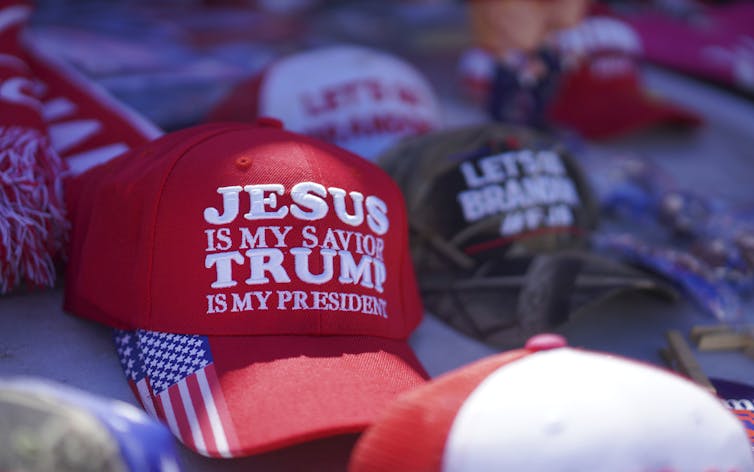During the 2024 presidential campaign, Donald Trump addressed a gathering of conservative Protestants, imploring them to vote for him "just this once."
"In four more years, the problem will be solved, everything will be fine, and you won't have to vote anymore, my beautiful Christians," he said.
As a scholar of religion and public life for the past 30 years, I had an immediate gut reaction: Such a blanket term was inappropriate. There is too great a diversity of Christian traditions, faiths, communities, and denominations to be lumped into “My Beautiful Christian.”
But in fact, Trump's words suggested something real. Despite this broad diversity, some social and political views among American Christians are becoming increasingly similar.
Social scientists often parse Christians into various Christian traditions: evangelical, fundamentalist, conservative Protestant, Catholic, Orthodox, Latter-day Saint, mainline Protestant, liberal Protestant—the list goes on. However, in my own work and that of some colleagues, a simple category has become more useful. This category of people is what I call "practicing Christians": people who call themselves Christians, whose faith is very important to them, and who go to church at least monthly.
For example, when it comes to views on immigration and racial inequality (the focus of my research), “practicing Christians” from different traditions are becoming increasingly similar. Voting behavior shows similar trends. This is especially true among white Christians, but also among most other racial groups.
social perspective
In 2000, the sociologist Christian Smith and I co-wrote a book about the uniqueness of white evangelical Christians in the United States and their racial beliefs.
White evangelicals are more likely than other white Christians to view race issues through the lens of individuals rather than society. That is, they tend to blame racial problems on bad people and bad relationships rather than factors like discrimination or unjust laws.
For example, using data from the 1996 General Social Survey, we find that white conservative Protestants are 26 percentage points less likely than white mainline Protestants to attribute racial inequality to a lack of access to quality education. These conservative Protestants (the term used for evangelicals in the survey) are 22 percentage points more likely than mainline Protestants to believe that a lack of motivation is the cause of racial inequality.
But just a few years later, scholars began to see that these differences were shrinking. In fact, when I compare the 2021-2022 General Social Survey to the 1996 survey results, the gap between mainline and conservative Protestant explanations for racial inequality has shrunk by about half.
In an analysis for our 2024 book, The Religion of White People , sociologist Glenn Bracey and I found that the gap between American Christians’ different traditional views on several social issues has narrowed to this to the extent that it is no longer advantageous to parse out different perspectives. Group. We can explain some of the patterns more effectively by using the category "devout Christians" compared to less devout Christians and non-Christians.
Bracey, Secretary Chad Brennan, and I co-led a national survey on race, religion, and social justice in 2019 that surveyed approximately 3,000 Americans. Illustrating this trend, one question asked respondents "whether it is acceptable that white people, on average, have more wealth than other racial groups." Nineteen percent of white practicing Catholics, 18% of white mainline Protestants, and 18% of white conservative Protestants agreed. By comparison, as we reported in White Religion, only 10% of other white Americans agreed.
political action
A similar pattern exists in presidential voting. Exit polls can't determine whether people meet the definition of "practice," but people who call themselves Christians are leaning increasingly toward the Republican Party overall.

Among white voters, the largest Christian tradition is shifting toward the Republican Party. For example, in 2004, 67% of white Protestants voted for the Republican presidential candidate. That same year, 56% of white Catholics also voted for the Republican candidate. By 2024, 72% of white Protestants and 63% of white Catholics support Republican candidates.
Since at least 2016, most Asian Christians have voted Republican. According to data from my Race, Religion, and Social Justice survey, only 26% of non-Christian Asians voted for Donald Trump in 2016, but 56% of Asian Christians did so.
I don't have the data to classify Hispanic Catholics into "practicing" or "non-practicing" categories, but by and large, they always vote for Democratic majorities. However, the gap is closing. In 2016, Clinton won 78% of the Hispanic Catholic vote. Four years later, Biden won 66%, while in 2024, Harris won only 55%.
African Americans are the exception to the overall Christian voting trend. In every presidential election since the 1960s, a majority of people have voted Democratic, regardless of their faith identity or lack thereof, and regardless of whether they would be described as "practicing."
Importantly, African-American devout Christians have been the only religious group to vote with Republican majorities in the past three presidential election cycles.
condensed culture
Well, unlike in the past, I think the category "Practical Christianity" is now a powerful way of understanding many social and political trends.
Why is there such a change? There are two main reasons combined.
First, church attendance has fallen significantly since 2000, while the number of “nones” (those who say they believe in no religion) has increased. In 2000, 42% of Americans attended services almost weekly or more, while by 2023, this had dropped to 30%. Likewise, the number of Americans who say they have no religious affiliation increased from 9% to 21%.
The decline in attendance is concentrated among mainline Protestants and Catholics — Christian groups that have been most likely to vote Democratic in the past and have more liberal social views.
There is no single Christian culture in America. However, the vast diversity is shrinking. And it is shrinking in one clear direction: toward conservative Protestantism.
"My beautiful Christian" remains a simple phrase that unites hundreds of faith traditions into one. But “devout Christians” are indeed becoming more alike—and this has a powerful impact on American life today.